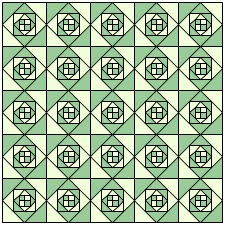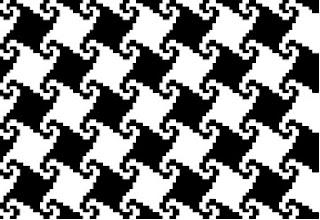I've been thinking about challenging pieced blocks lately and I remembered what a challenge this Snail's Trail pattern is. Many years ago I made one for a niece born in Indiana. Indiana Puzzle is another name for it and I liked the negative/positive aspects of the design. Mine was red and green as I recall.
The block has several names and variations.
Ruby McKim called it Monkey Wrench or Snail's Trail in the 1920s.
Quilter's Newsletter called it Indiana Puzzle in 1976, which must be where I got the idea. Other names are Journey to California, and Whirligig Quilt.
#2398 in BlockBase
It's not that hard to make---especially if you put a four-patch in the center and piece it on a paper foundation. Variations include more squares inside of squares inside of squares.
#2398 with shading
It's not that hard to make. It's hard to set it right and get the illusion.
Following that shading around in a circle gets confusing if you have a little spatial relations problem.
Note errors at left and on bottom.
This one's folded but that top left corner has a problem.
You can't just set the blocks side by side
You have to rotate every other block.
McKim and others suggested an alternate plain block and that makes it even harder to set---if faster to piece.
This is NOT the way to do it. It looks like lizards.
You have to rotate the rows and alternate the colors.
That requires a lot of heavy concentration for me.
The illusion is based on what we call a hound's tooth check, an old weaving pattern.
A pattern that is still popular.
Here's an outfit by the late Alexander McQueen.
Carol Gilham Jones played with the pattern to great effect.
I think this one is from the 1980s.
If you are interested in making the design there are many new patterns and how-tos available. Do a web search for the three words quilt snail trail or quilt monkey wrench. Here's a challenge from Electric Quilt.
And links to a few examples.
See Susan's very first quilt!
http://susanscloches.blogspot.com/2011/05/very-first-quilt-i-made.html
A great black and white example from the 1920s in the Quilt Index
http://www.quiltindex.org/fulldisplay.php?kid=57-90-2D0
I should loosen up and just go with it as Mary Maxtion has done. Click here and scroll down to see her pink and black version
http://antiquesandthearts.com/2009-08-25__14-12-28.html&page=2
and one in red and black at the International Quilt Study Center and Museum
http://cdn.firespring.com/images/8bf318c6-2229-44fc-a04b-cf02851a5688.jpg














I had vertigo last week, that pattern was too much for me, lol.
ReplyDeleteDebbie
Another informative, and fun post! Thanks for sharing so generously.
ReplyDeleteThanks for that tutorial on monkey wrench! I love that pattern and tried to make it some years ago. I think I didn't rotate the blocks and I really didn't like the way it looked, so in the trash it went. I also wasn't paper piecing, which I think would be a great help.
ReplyDeleteThis is on my TO DO list...I love the green and white one. The list keep growing longer!
ReplyDeleteGreat post - such a graphic quilt and you make it seem not quite so hard..would like to work up to this but I suppose I could just make bigger and fewer blocks!
ReplyDeleteI inherited a green and white Monkey Wrench that has some definite setting issues...it was my ancestral great-great-aunt quilter's last quilt, and you can see where she sort of "lost" the pattern...but decided she had to baste and quilt it anyway. It's a sad story -- and she never finished it.
ReplyDeletelady gaga was dressed head to toe in large hounds-tooth while on The View this week. wait for it....her piano, microphone, stool. her business suit, hat, even the lens in her sunglasses all large black\white hounds-tooth, lovely. love your blog. :>)
ReplyDeleteGreat information about the Snail's Trail block. I've been doing some research on this block and have found in an old quilt book and old Quilter's Newsletter Magazine an applique snail's trail from the mid 1800s. It looks nothing like the block we know today. It is placed diagonal on a 6-1/2" block. The ends are 3/4" wide with a elongated bubble in the center. the four come together in the corner and set together creat a finished 12" block. I looked in your Encyclopedia for Appliqued blocks and didn't see it. Are you familiar with this early Snail's Trail variation? Thank you. Peggy
ReplyDeleteAnother informative, and fun post! Thanks for sharing so generously.
ReplyDeleteHi!
ReplyDeleteI just wanted to say thank you for posting this and for keeping it here. I love this pattern. I am a 3rd grade teacher, and I am making different quilt block patterns on paper, to help my kids practice multiplication. They are kind of a color by number with the multiplication problems in the center of each "piece" to provide the number for the color.) (This is not an original idea. I am following in the footsteps of Debra Baycura, who published a book called Patchwork Math 2, which I have used for years. However, I have had to branch out on my own to provide more practice with individual sets of multiples, i.e., x 4, in isolation.)
Peggy Gelbrich, the afore-mentioned book features the old Snail's Trail block you described.
Sincerely,
Julia Ross